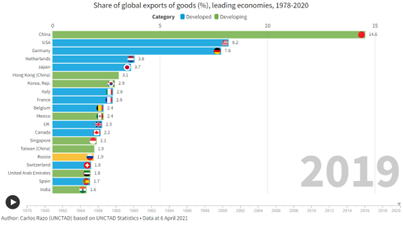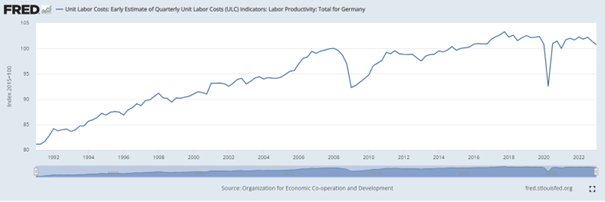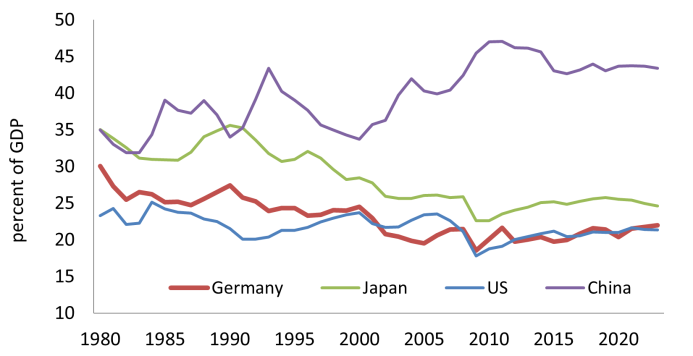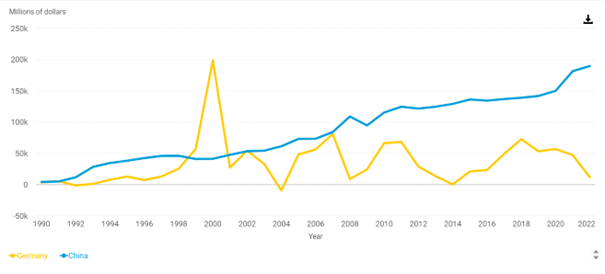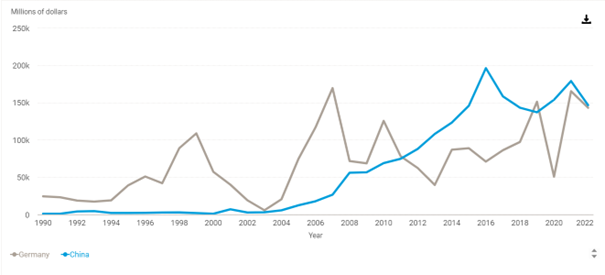Germany is the euro area’s economic powerhouse and most competitive economy. It accounts for close to 30 percent of the euro area gross domestic product (GDP) and has recorded sizable current account surpluses since the introduction of the euro. Substantial fiscal and labor market reforms in the early 2000s propelled the German economy.
However, these golden days seem all gone now. Years of misguided energy policies—part of the government’s interventionist green agenda—increased energy prices and uncertainty for investors. In addition, the business environment deteriorated due to heavy bureaucracy and taxation, seriously weakening Germany’s productivity and output growth. The real beneficiary of Germany’s economic woes seems to be China, which has replaced it as the top global manufacturing hub and exporter.
Germany’s Deteriorating International Competitiveness
With around 13 percent of global exports, West Germany was the world’s undisputed export leader in the 1980s. Its exports were slightly higher than that of the United States and about ten times bigger than China’s. As world trade grew strongly in the 1990s, Germany got bogged down in domestic welfare redistribution to rebuild East Germany after reunification and missed the early globalization train. Its labor costs surged by almost 20 percent in the early 1990s, denting external competitiveness. Germany’s share in world exports fell from 12 percent in 1990 to 8.5 percent in 2000. China’s accession to the World Trade Organization in 2001 unleashed a surge in foreign direct investment (FDI) inflows and exports and made it the world’s undisputed export champion by 2010. Germany’s share in global exports shrank further, falling below 7 percent by 2022 (figure 1).
Figure 1: Share of global exports of goods
Source: UNCTAD [link: China: The rise of a trade titan | UNCTAD]
China has been Germany’s main trading partner for seven years now, but the trade balance with the latter turned from a surplus into a deficit of more than $80 billion last year. Going up the value chain, China’s exports have become a redoubtable challenger in high-value-added sectors, such as mechanical engineering, chemicals, and now cars. Over the last twenty years, China has surpassed Germany as the world’s largest exporter in electric and information technology products, machinery, and chemical products. Moreover, China’s share of European Union imports of this category of goods surged to 13 percent in 2022, almost catching up with Germany’s shrinking share of 15 percent.
The most dramatic change of fortunes for German companies is taking place in the car sector. The transition to electric vehicles (EVs) driven by the West’s green agenda backfired monumentally when China leapfrogged Western carmakers and became the global leader in EVs. China’s breakthrough did not come primarily from heavy government subsidies and pampered state-owned enterprises—as wrongly believed by mainstream pundits—but from the emergence of nimble independent producers and from tougher competition from foreign entrants such as Tesla. Today, German car-making giants like Volkswagen, Mercedes-Benz, and BMW are teaming up with Chinese partners to draw on the latter’s superior know-how and technology in batteries, automotive software solutions, and autonomous driving. China’s annual car exports surpassed those of South Korea in 2021 and of Germany in 2022 and are now on track to beat Japan’s this year.
How Did the German Economy Get into Trouble?
Many arguments put forward by mainstream pundits have either little relevance or can be easily debunked. In the case of Japan, an aging population and a shrinking labor force are wrongly perceived as the main contributors to anemic growth rates. More than 40 percent of German companies are complaining about shortages of skilled labor, despite a high employment rate. Job vacancies also reached a new record last year.
Despite shrinking projections, however, the active population has increased over the last two decades by more than five million people, helped by immigration. In addition, there are still untapped sources of labor: half of women work only part-time, workers can retire already at the age of sixty-three under an early retirement scheme, and Germans work among the fewest hours per year on average compared to other countries, according to the Organisation for Economic Co-operation and Development—about a quarter less than Americans and almost 40 percent less than the Chinese.
The shortage of skilled workers is actually driven by poor skills and the lack of work incentives rather than a falling number of workers. Companies report that the quality of young apprentices has deteriorated steadily. The famous German dual vocational training system seems to be in a crisis, due to a misguided focus on academic education. Even the number of tertiary education graduates is significantly below the EU average.
What seems to be the Achilles’ heel for German competitiveness is the stagnation of labor productivity growth. Since the late 2000s, the output per hour worked has barely increased due to underinvestment in physical and human capital (figure 2). For some time, Germany coped with this problem through wage restraint. However, since the euro crisis, nominal unit labor costs have been rising faster than in the rest of the eurozone, rendering Germany’s exports more expensive. Not only has Germany’s capital accumulation slowed, so has its innovation capacity. From 2007 through 2022, Germany dropped from the second to the eighth place in the Global Innovation Index, while China surged from the twenty-ninth to the eleventh position.
Figure 2: Labor productivity
Source: FRED [link: Unit Labor Costs: Early Estimate of Quarterly Unit Labor Costs (ULC) Indicators: Labor Productivity: Total for Germany (ULQELP01DEQ661S) | FRED | St. Louis Fed (stlouisfed.org) ]
Weak productivity growth stems from a sizable slowdown in investment. Germany’s investment ratio to GDP fell by about 10 percent from 1980 to 2022 (figure 3). Mainstream analysts pin this down to chronic public underinvestment in transport and digital infrastructure, allegedly due to fiscal restraint and a “debt brake” introduced in the constitution in 2009. However, the debt rule was often circumvented with the setup of off-balance sheet funds. In addition, a significant part of the planned public investment—part of a lavish total budget envelope of 50 percent of GDP—goes unspent because of a slow process of planning, approving, and executing investment projects.
Figure 3: Investment ratio
Source: IMF WEO [link: World Economic Outlook Database (imf.org) ]
Underinvestment by private companies seems even more acute. Almost a third of German industrial companies favor investment abroad over domestic expansion. The reluctance to invest in Germany applies also to foreign investors and has been going on for many years. Since the early 2000s, FDI in Germany has fallen sharply, and the unfavorable gap relative to China has widened considerably (figure 4).
Figure 4: FDI inflows
Source: UNCTAD [ link: World Investment Report 2023 | UNCTAD ]
At the same time, German investment abroad has soared during the past decade, leaving Germany with a whopping negative FDI balance. Investments of €125 billion left Germany on a net basis in 2022, hitting another record after reaching €110 billion in 2021 (figure 5). China already has a stock of inward FDI that is 3.5 times bigger than Germany’s.
Figure 5: FDI outflows
Source: UNCTAD [ link: World Investment Report 2023 | UNCTAD ]
Investors complain about policy uncertainty, in particular regarding the supply and cost of energy. Germany’s manufacturing sector had already been falling steadily before the loss of cheap gas from Russia hit it even harder. After the closure of nuclear power plants, many firms are looking for relocation to greener and cheaper pastures until the windmills promised by politicians to meet the target of 80 percent renewables are built. The future of commercial relations with China is also unclear given heightened geopolitical risks.
Most important, a deteriorating business environment discourages investment. Stifling bureaucracy, red tape, and a heavy tax burden propping up the bloated welfare system reduce economic freedom and drive investment away. According to the Global Competitiveness Index, Germany fares relatively poorly in international comparison in terms of information and communication technology adoption, labor market rigidities, and labor taxation. As a result, Germany now provides dozens of billions in subsidies to attract foreign investment in high-tech sectors such as chipmaking and EVs.
Conclusion
Many years of interventionist green policies and reform backtracking coupled with a traditional heavy government footprint have dented Germany’s manufacturing competitiveness. Analysts remain optimistic about Germany’s capacity to reinvent itself based on the resilience of its innovative “Mittelstand” and still-favorable fiscal position. However, rather than subsidizing investment and the interventionist green agenda, Germany should heed the lessons of the early 2000s and choose market-oriented reforms again.
Full story here Are you the author? Previous post See more for Next postTags: Featured,newsletter









